Let’s open with some interesting facts…
- 71% of business and marketing executives who exceeded their revenue goals had documented buyer personas.
- Of the companies that missed their goals, only 26% of them used buyer personas.
- Open rates can drop 25% when adding +13 words to your subject line.
- 15% of booking rates came from emails that mentioned prospects 6-10 times.
- +50% of booking rates came from emails that had 120 words.
- Click rates for emails with images are 42% higher CTR than those without.
- Including too many emojis can lower your open rates by 13%.
- Personalization can increase your open rates by 50%.
What is cold email copywriting?
Cold email copywriting is basically crafting persuasive and engaging messages for potential leads or clients who have no prior relationship with you.
You have to capture attention, build trust, and compel recipients to take a specific action: replying, booking a call, purchasing, etc.
It’s harder than it sounds.
As opposed to writing a traditional email to a friend, coworker, or boss, cold email copywriting requires you to create a genuine connection with a stranger in only a few words.
Also, your cold email is among dozens of messages that your prospects will be receiving daily.
So you have to stand out from the crowd and convince your prospects to take action without coming off as gimmicky or sales-y.
It’s a fine line to walk.
That’s why we’ve analyzed the data from millions of lemlist cold email campaigns, to identify key statistics and insights that will help you fine-tune your cold email copywriting to get more replies and book more meetings.
Let’s get started.
7 cold email copywriting best practices based on data
Here are the 7 best practices for cold email copywriting that will help you write messages that convert.
1. Target the right people
Even the best-written cold email campaigns will fall flat if they’re not being sent to the right people.
In one survey, 137 business and marketing executives were asked if they create and document buyer personas as a part of their strategy.71% of those who exceeded their revenue goals had documented buyer personas.
Of the companies that missed their goals, only 26% of them used buyer personas.
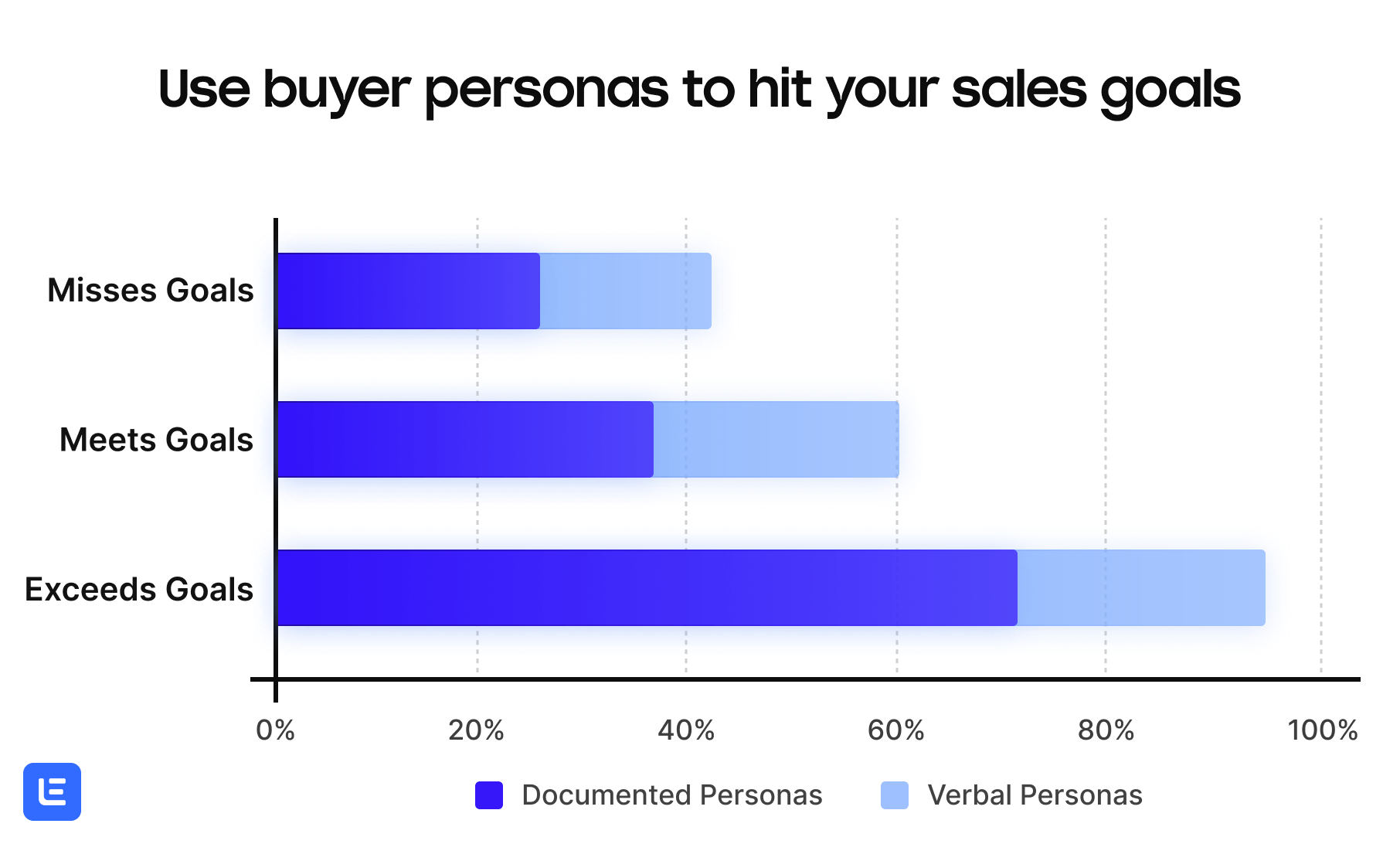
Essentially, if you start your cold outreach with a specific buyer persona in mind, and find contacts that match this persona, you’re much more likely to meet or surpass your goals.
So before you even write your cold emails, you must stop and define the audience that you’ll be sending them to.
What steps should you follow to define your target audience?
→ Make a list of your best clients
→ If you don’t have clients, list potential clients and start networking with them
→ Research the attributes of the clients on your list
→ Identify the common attributes across multiple clients
→ Create a fictional profile of the person who would buy your product from each of the clients with common attributes
→ In the profile, include their position, age, goals, path to purchase, and obstacles
→ Separate your buyer personas into tiers, from most to least revenue
Once you have your buyer personas ready, prioritize the tier-one personas. This allows you to concentrate your efforts on the clients who are most likely to bring in revenue the fastest.
For a complete guide on identifying your target audience, use our guide on ICPs and buyer personas.
2. Start with a killer subject line
Once you have a list of targeted recipients for your cold emails, it’s time to begin the copywriting.
The first thing your prospects will see is the subject line.
In fact, it’s one of the most important factors in defining if your email gets opened and read, or ignored.
The first thing to know about subject lines: the shorter, the better.
When we analyzed millions of cold email campaigns, we saw that the emails’ success rates dropped with every extra word added to a subject line.
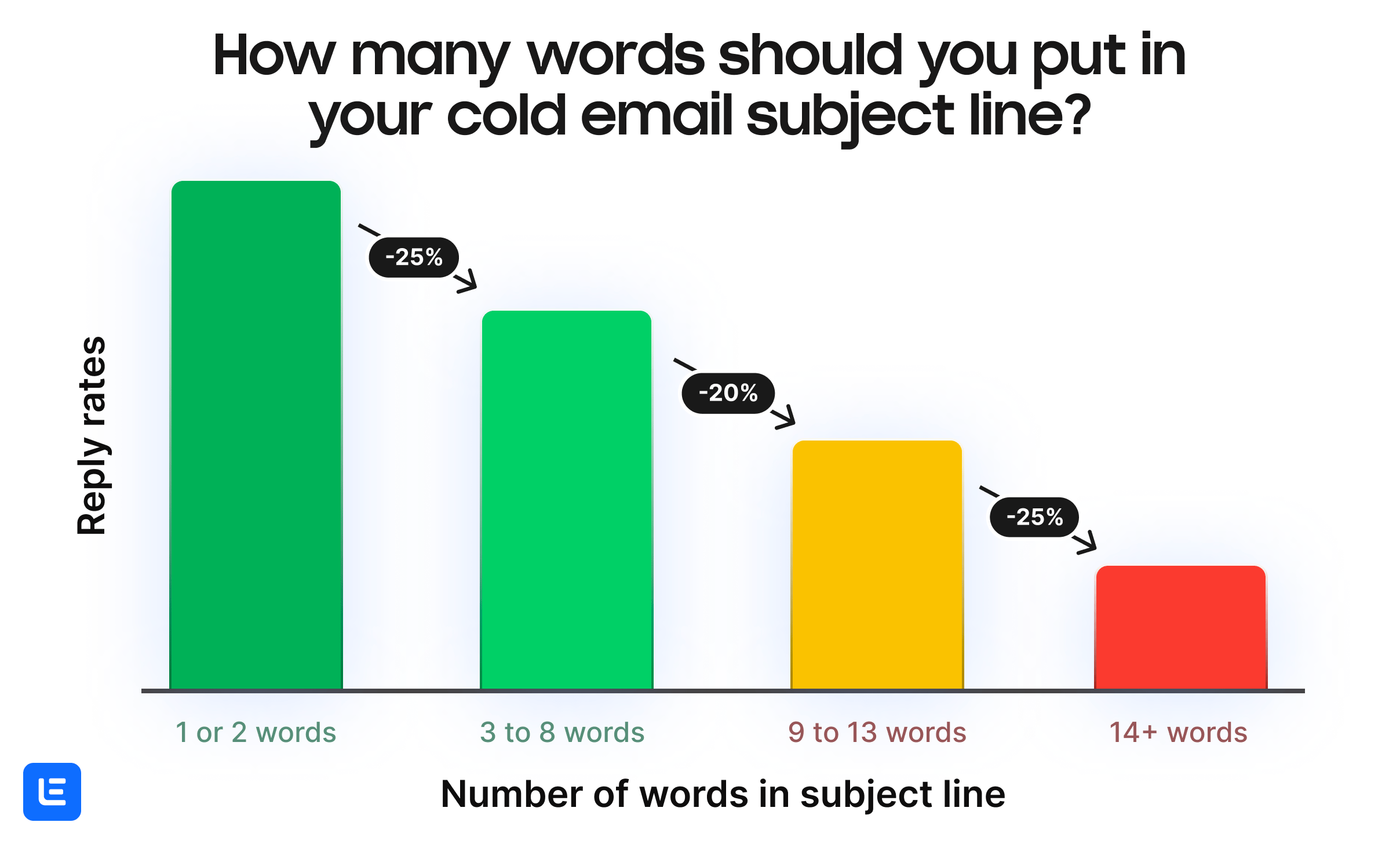
So when you’re writing your cold email subject lines, aim for 8 words or less.
It helps prospects understand your message as quickly as possible, and won’t get cut off on mobile.
Other best practices to keep in mind with your cold email subject lines are:
→ Personalize your subject lines by using text variables like {{painPoint}} or {{Objective}}, or by referencing a detail specific to the prospect.
→ Ask a question if it’s actually relevant to your prospects.
→ Add urgency and FOMO by referencing exclusive events or offers (if relevant).
→ A/B test your subject lines to find out what your audience responds to.
To learn more about cold email subject lines, plus examples of 10+ subjects with 80%+ open rates, read our data-based guide on B2B cold email subject lines.
3. Focus on your prospect
Too many cold emails start with “Hi, my name is…” or “To introduce myself…”
Prospects aren’t interested in who you are and what you do.They’re interested in how you can help them achieve their goals.
To measure this, we grouped emails by how frequently they talked about the prospect, as opposed to the sender.
To quantify “mentioning the prospect,” we measured the number of times the email included the word “you,” “your,” “yours,” etc.
And we found that, out of millions of cold emails, the ones that most mentioned the prospect got the highest average booking rates:
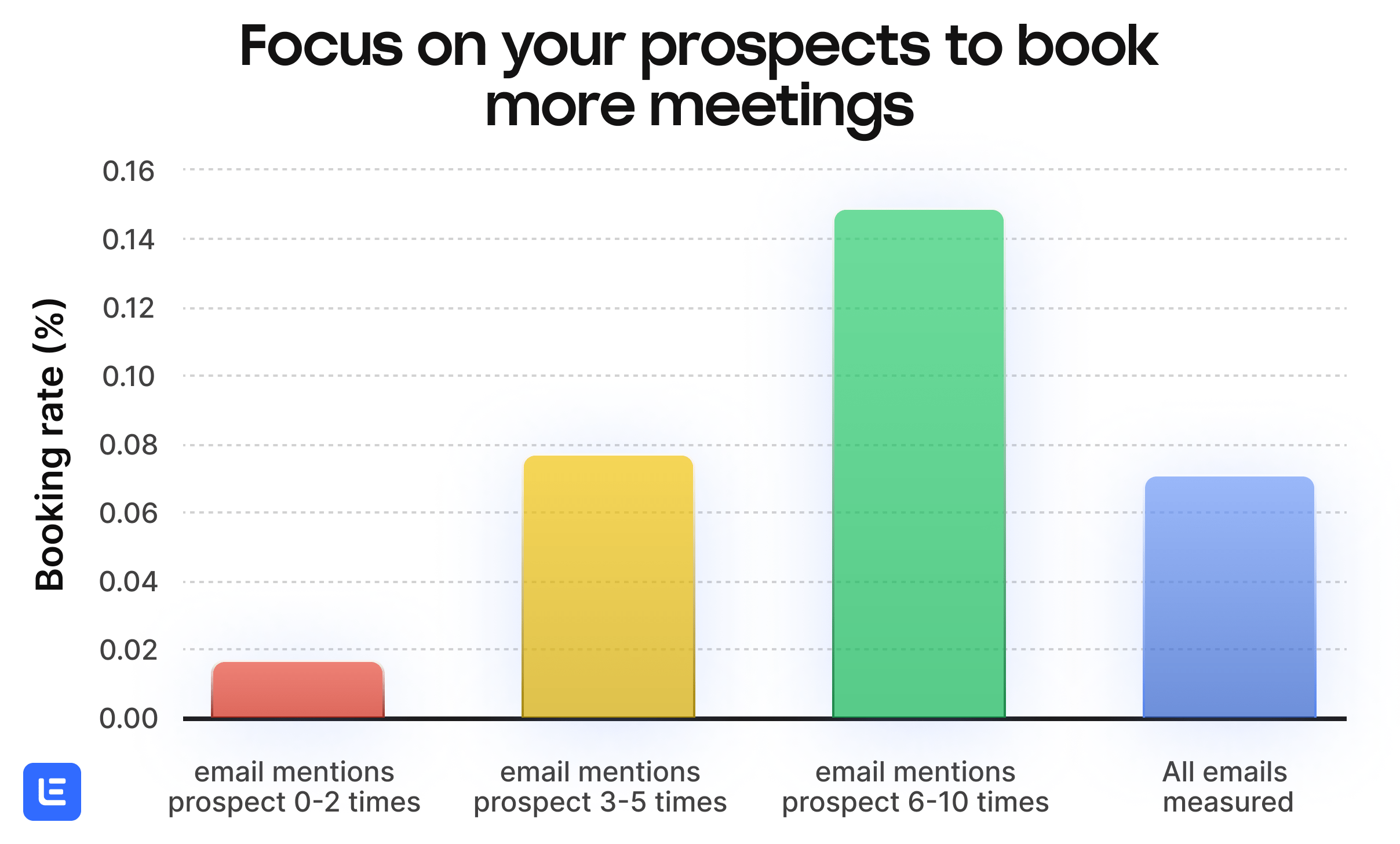
So what does this mean for your cold email copywriting?
Make your prospect the focus of every cold email, not you.
Here’s an example:
![A screenshot of a cold email. The text says "Hi Nadja, I’m Gina, a representative from [Company Name], and we specialize in automating sales processes for busy BDRs and sales reps. We’ve been helping sales teams for the last 3 years, and recently received M in our most recent funding round. I saw that lemlist focuses on personalization and multichannel sequences, but it can take a long time to add enrichment, reach out to inbound leads, browse on LinkedIn, do CRM clean-up, and so on. Do you want to hop on a call to discuss how [Company Name] can help you achieve your goals? Best,
Gina"](https://www.lemlist.com/wp-content/uploads/2024/09/64aff3efa32adb484e7f211d_Frame2095352203-min.png)
Here, Gina starts her email with a long section talking only about herself and her company.
There is no hook to draw the reader in, nor is it immediately clear what her connection is to the prospect.
Here’s another version of the same outreach email, this time focusing on the prospect:
![A screenshot of a cold email. The text says "Hi Nadja, Been following for a bit now, and while this is old news I still find it super impressive that you helped grow the business from M to M; aiming for M this year!
While lemlist focuses on personalization at scale and multichannel sequences, I know it typically takes me a few hours a day to do my work efficiently. Many of those manual tasks can be automated. If I can show you how [my company] can automate the enrichment of your TAM accounts, CRM clean-up and more, would it be interesting? Either way, congrats on the huge growth! Best,
Gina"](https://www.lemlist.com/wp-content/uploads/2024/09/64aff41308098edeb072ef8c_Frame2095360202-min.png)
This email only mentions the sender’s company one time and devotes the rest of the email to the prospect’s company and needs.
She shows that she knows the prospect by congratulating her on the company’s funding round, and she clearly states what the prospect can get out of this email: saved time by automating sales processes.
4. Aim for 120-word cold emails
It can be tricky to pinpoint the best length for your cold emails.
Should you write long messages that get all the details across, or write short ones that are easier to read?
We put that question to the test by analyzing the booking rate of thousands of cold emails.
On average, emails around 120 words had the highest levels of success.
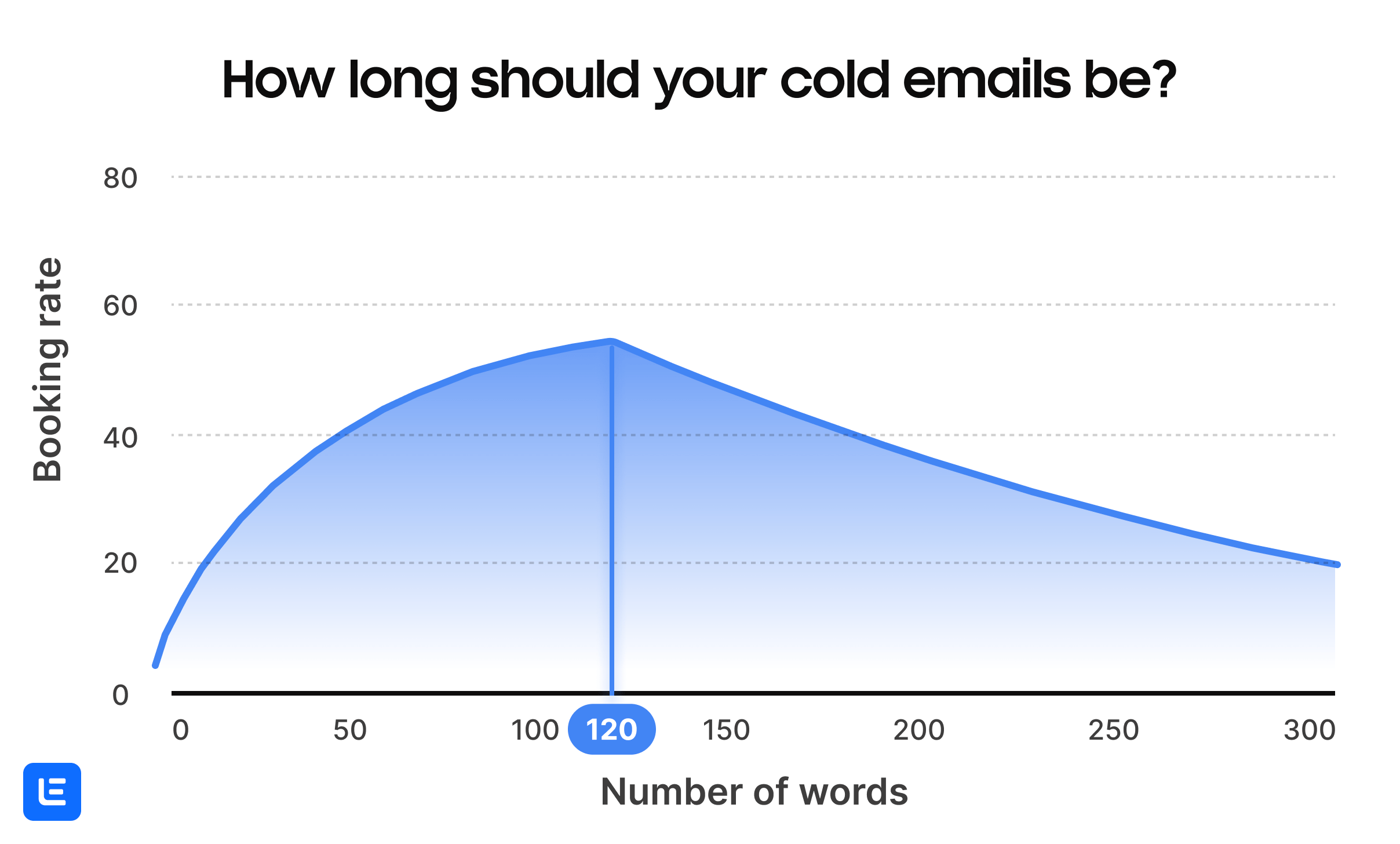
Granted, that doesn’t mean that you need to hit exactly 120 words every time you write a cold email.
Aim for the range of 75-125 words to give enough information for the prospect to understand your message, without rambling.
And don’t neglect the formatting of your email: the 120 words should be readable and easy to scan.
That means breaking up your text into shorter paragraphs of 1-2 sentences each, with line breaks between each paragraph.
Your prospects will only spend a few seconds looking at your cold email. So keep it short and as easy to read as possible.
For the full data analysis of cold email length and formatting, check this article on optimizing your cold email length for more replies.
5. Use images if appropriate
When your cold emails are limited to about 120 words each, a great way to get your message across without adding bulk is to include an image or two.
When we analyzed the reply rates of emails with and without images, we found that adding 1 or 2 images could boost your success:
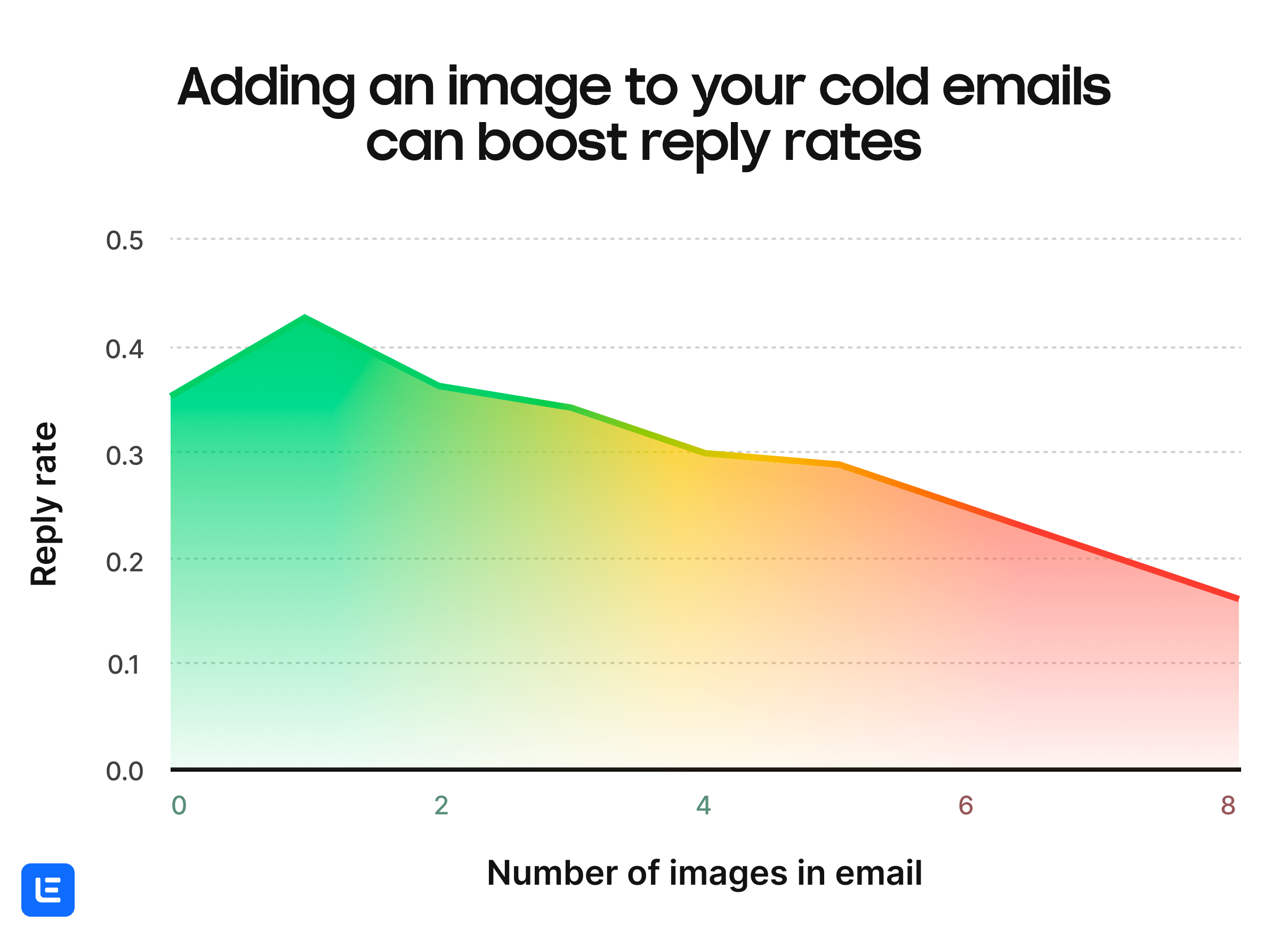
However, adding more than 2 images puts you at risk of lower reply rates, or, if the file size is too large, getting flagged as spam.
To learn more about images and email deliverability, take a look at this data to know if images will land you in spam.
So when deciding whether to add images to your campaign, make sure they are:
→ no more than 2
→ tailored to your prospects
→ compressed
To learn more about the risks and benefits of including images in your cold email campaigns, read our full report on images in cold email campaigns.
6. Use the right tone for your target audience
B2B cold outreach doesn’t have to mean “boring to boring” – you can add a little personality by using casual language, emojis, and exclamation points.
You just have to make sure it’s the right match for your target audience.
First, let’s take a look at emojis in cold emails.Should you use them?
When we analyzed the average reply rates of emails with and without emojis, we found that emails with emojis got an average of 13% lower reply rates.
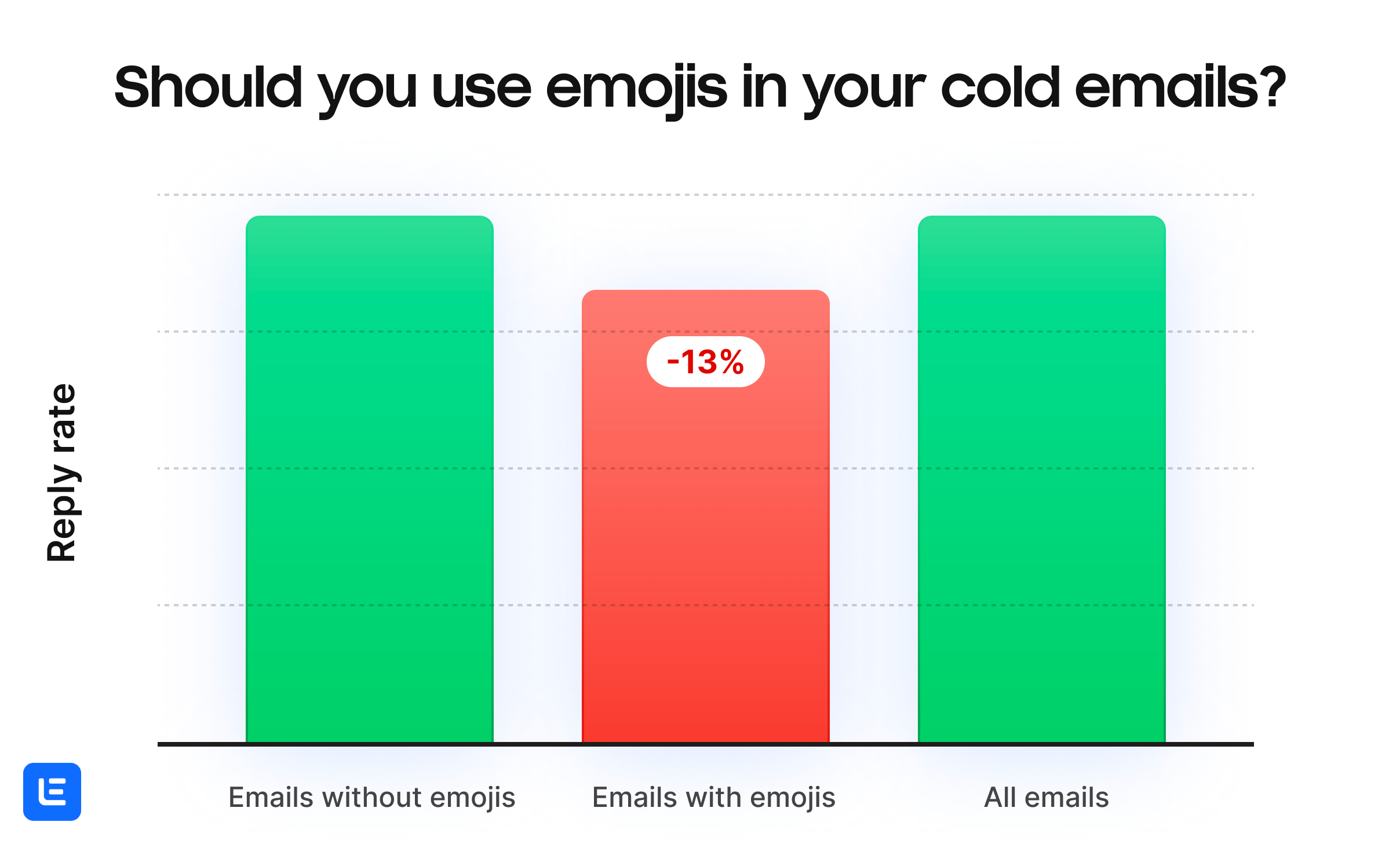
However, this data set included emails with any number of emojis: from 1 to 20+.
If you only include 1-2 emojis in an email that’s targeted to an audience who uses them (influencers, freelancers, solopreneurs), you’re safe.
As for exclamation points, the results are similar:
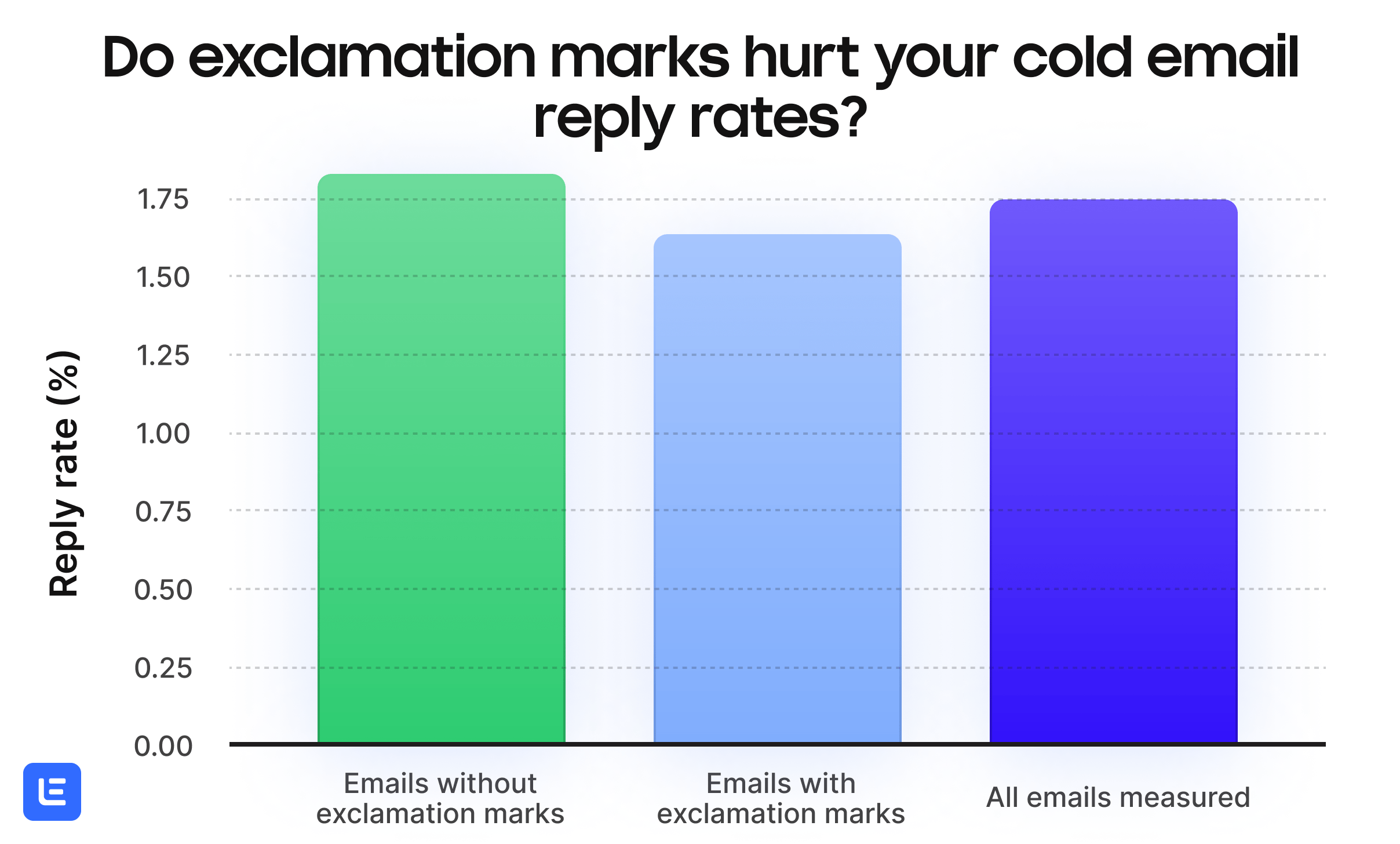
Emails without exclamation marks did get a slightly higher average reply rate than emails with exclamation marks.
If in your audience research, you found that your target audience prefers formal language, it’s best to stay away from casual details like emojis and exclamation points.
If you’re not sure, A/B test your campaigns to find out which tone of voice is the most successful with your audience.
For more information, use this step-by-step guide on A/B testing to fine-tune your cold outreach results.
7. Personalize at scale
Finally, one of the most important practices in cold email copywriting is to personalize your messages to your prospects.
In fact, studies show that personalization increases cold email open rates by up to 50%.
That means using their first name, using icebreakers that are specific to the prospect, identifying common pain points and objectives, referencing their competitors, and using any other detail that connects with them.
Of course, you could manually research and type out every individual cold email to be personal to your prospects. But this will take hours out of your day, limiting the time you actually get to meet with them and follow up on replies.
Instead, personalize your cold emails at scale by using text variables like {{firstName}} or {{companyName}}, and even image and video variables that are customized to your prospects’ landing pages.
One of the easiest and fastest ways you can do this is with a sales automation tool like lemlist.
It’s a tool that allows you to generate multi-step sequences like this:
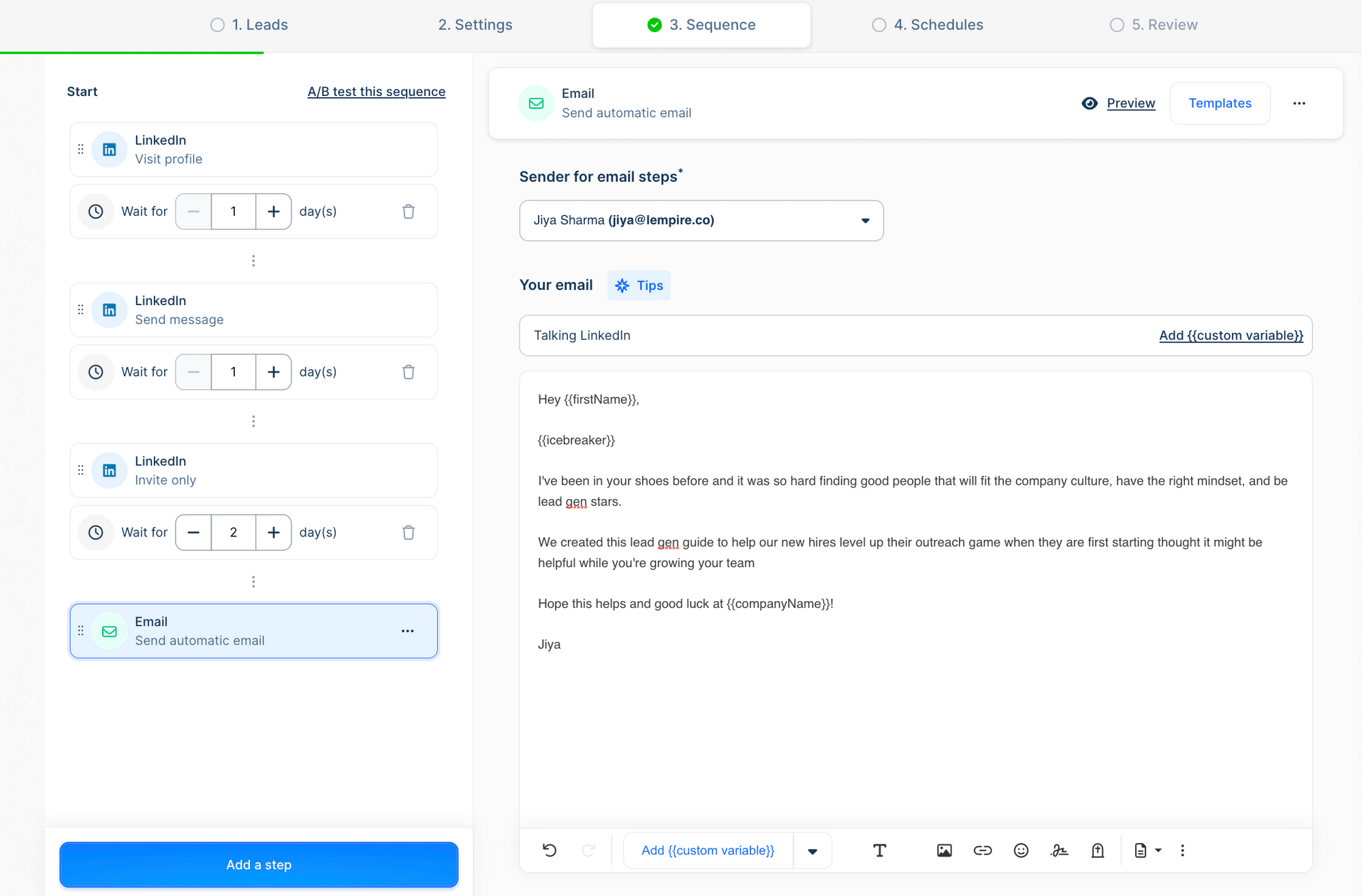
It includes personalized text, image, and video variables that are automatically personalized to all of your prospects.
And if you’re still stuck on your cold email copywriting, there are automatic templates that you can apply.
They’ve already been optimized with each of the best practices listed above, so all you have to do is fill in the blanks.
If you’d like to give lemlist a try, you can create your first campaigns without even entering your card information.
Key takeaways
To recap, here are the best practices to optimize your cold email copywriting:
- Target the right people: Define your audience with buyer personas and prioritize high-revenue prospects.
- Craft compelling subject lines: Keep them short and personalized, ask relevant questions, and A/B test.
- Focus on your prospect: Make your emails about them, addressing their needs and goals.
- Keep it concise and readable: Aim for 120-word emails with shorter paragraphs.
- Consider using images: Include 1 or 2 relevant images, compressed and tailored to prospects.
- Tailor your tone to your audience: Use casual language if appropriate, but stay formal if necessary.
- Personalize at scale: Use automation tools and variables for personalized messaging.
Need more help with your cold email copywriting?
Use our database of proven successful cold email templates.
Your source of actionable outreach tips and strategies that will help you get replies and grow your business.

